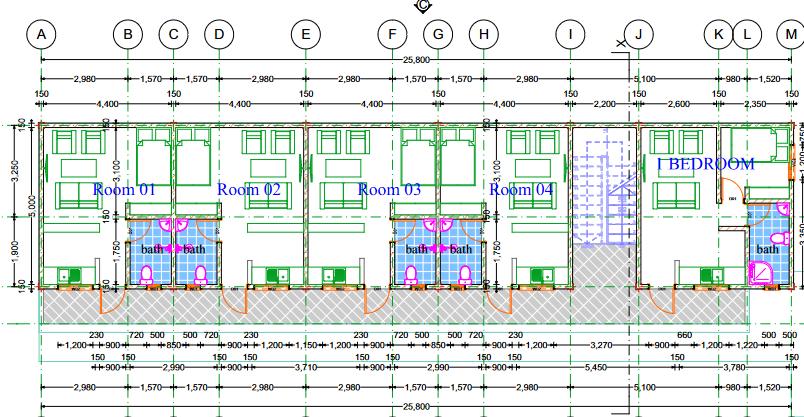What Is an Architectural Floor Plan & Why Does It Matter?
Definition & Purpose
An architectural floor plan is a drawing that shows a building from above. It explains how rooms, walls, doors, and windows are arranged. The purpose is to help people understand space, flow, and how the design will look before construction begins.
Who Uses Floor Plans (Homebuyers, Students, Contractors)
Floor plans are useful for different groups. Homebuyers use them to picture their future homes. Students use them to learn design basics, while contractors depend on them to guide actual building work.
Concept vs. Design vs. Construction Plans
Not all floor plans are the same. Concept plans are rough sketches that show ideas. Design plans add more details like measurements and materials. Construction (working) plans are the final blueprints used on-site to build the project.
Related post: Luxury Villa Designs in Nairobi — Floor Plans & Costs
Floor Plan Symbols, Abbreviations & Legends
Common Symbols (Walls, Doors, Windows, Fixtures)
Floor plans use simple symbols to represent building parts. Solid lines often show walls, while door symbols indicate how a door swings open. Windows, stairs, sinks, and other fixtures each have unique icons that make the plan easy to read.
Architectural Abbreviations Explained
Alongside symbols, abbreviations save space on drawings. For example, “WC” means water closet, “DW” stands for dishwasher, and “CL” shows a closet. These short codes help keep the plan neat but require some learning to understand.
Why the Legend Is Essential
Every good floor plan includes a legend or key. This section explains all the symbols and abbreviations used on the drawing. Without it, even experts can misread important details.

Reading Dimensions, Scale & Measurements
Understanding Scale Types (Architectural vs. Engineering)
Floor plans are drawn to scale so that measurements can fit on paper. An architectural scale is common in home design, where 1/4 inch might equal 1 foot. Engineering scales are used more for site layouts and infrastructure projects.
Calculating Room Sizes & Clearances
Dimensions on a floor plan show the length and width of each space. By adding up these numbers, you can work out the total area of a room. Clearances, like space for doors to swing or hallways to remain passable, are also marked for safety and comfort.
Converting Plan Dimensions Into Real Space
To picture the actual size of a room, convert the scale back into real-world measurements. For example, if a wall is 2 inches on paper at 1/4 inch = 1-foot scale, the real wall is 8 feet long. Practising with a scale ruler or digital tools makes this process easier.
Related post: Modern 3-Bedroom Maisonette Designs in Kenya: Plans, Costs & How to Build
Layers Beyond the Basics: Structural & MEP Details
Structural Elements (Columns, Beams, Foundations)
Structural parts of a building are shown on floor plans to guide construction. Symbols may mark columns, beams, or load-bearing walls. Foundations are also included since they support the entire building’s weight.
MEP Plans (Mechanical, Electrical, Plumbing)
MEP drawings add another layer of detail. Mechanical plans cover heating and cooling systems, electrical plans show outlets, switches, and wiring, while plumbing plans mark pipes, sinks, and drainage points. Reading these ensures the design works in real life.
Elevations, Sections & Callouts
Floor plans often include references to other drawings. Elevations show a side view of the building, while sections slice through the design to reveal hidden details. Callouts point to specific areas that need closer inspection.
Related post: Stylish 3 Bedroom House Designs in Kenya: Bungalows, Mansions & Flat Roof Plans for Modern Living
How to Practice Reading Floor Plans Effectively
Free Samples & Templates to Download
The best way to learn is by using real examples. Many websites and design tools offer free floor plan samples. These templates let you practice identifying symbols, measurements, and layouts without pressure.
DIY Exercises for Beginners
Set simple challenges for yourself. Try labelling all doors and windows on a plan, or calculate the total area of a living room. Repeating these exercises builds confidence and helps you spot details faster.

Quizzes & Worksheets for Skill Validation
Quizzes and practice worksheets are great for testing what you’ve learned. Some online courses provide exercises where you must read a plan and answer questions about dimensions or features. This helps you measure your progress over time.
Related post: What Two-Bedroom House Plans Should You Choose in Kenya?
Tools & Software That Make Reading Plans Easier
Free Floor Plan Viewer Apps
Several free apps let you open and view architectural floor plans on your phone or computer. They help you zoom in, measure distances, and check symbols without buying expensive software. These are perfect for beginners who want hands-on practice.
Paid Software & CAD Tools
Professional software like AutoCAD, SketchUp, or Revit offers advanced features. They allow you to manipulate floor plans, create 3D models, and check measurements accurately. Paid tools are ideal for students, architects, and contractors who need precision.
Online Courses & Learning Platforms
Many online platforms offer courses in floor plan reading and blueprint interpretation. These courses guide you step by step, often including practice files and quizzes. They’re a great way to combine theory with hands-on learning.
Buying Floor Plans: What to Know Before You Pay
Licensing & Modification Rights
When buying a floor plan, check its licensing terms. Some plans allow you to modify layouts freely, while others restrict changes. Understanding these rights helps you avoid legal issues later.
Pre-Drawn vs. Custom Floor Plans
Pre-drawn plans are ready-made and often cheaper, but may not fit your exact needs. Custom plans are tailored to your space and preferences, though they can cost more. Choose based on your budget and project requirements.
Red Flags When Buying Online
Avoid sellers who lack clear licensing information, provide no previews, or have poor reviews. Be cautious of plans that seem too cheap, as they may be low-quality or copied. Always verify the source before purchasing.

Common Mistakes to Avoid When Reading Floor Plans
Misreading Dashed Lines or Scale
Dashed lines can indicate hidden elements like overhead beams or features below the floor. Misinterpreting them or ignoring the scale can lead to serious errors in planning or construction. Always double-check the legend and scale before measuring.
Ignoring Door Swings & Circulation Paths
Doors and hallways affect how people move through a space. Ignoring door swings or circulation paths can make a room feel cramped or unusable. Pay attention to these details for accurate planning.
Overlooking Storage & Utility Areas
Floor plans often include closets, storage, and utility spaces. Overlooking them can cause surprises later, like missing space for appliances or storage needs. Check all labelled areas before finalising your plan.
Keyword Opportunities & Buyer’s Guide Add-Ons
Best Keywords to Target for Training & Tools
Use long-tail keywords naturally to attract people ready to buy courses or tools. Examples include “architectural floor plan course online” and “floor plan software for homebuyers.” These help capture transactional search intent.
Comparison Table: Free vs. Paid Software
Compare features, pricing, and usability of free and paid floor plan tools. This helps beginners choose the right software for practice and professionals pick tools for serious work.
Bonus: Free Symbol Cheat Sheet Download
Offer a downloadable cheat sheet with common floor plan symbols and abbreviations. It’s a helpful resource for beginners and encourages them to engage with your content or courses.
Download our [Free Floor Plan Symbols PDF Guide].

Next Steps: From Floor Plan Basics to Design Confidence
Recap of Key Lessons
You’ve learned how to read an architectural floor plan, understand symbols, measure dimensions, and interpret structural and MEP details. Practising with real plans helps reinforce these skills.
Where to Continue Learning
Consider using online courses, software tools, and downloadable templates to deepen your knowledge. Regular practice with new floor plans improves accuracy and builds confidence.
Take the next step by downloading our free cheat sheet or enrolling in a beginner-friendly floor plan course. Applying what you’ve learned will help you read any plan with ease.
Get started with our [Beginner to Advanced Architecture Learning Path].
Conclusion – Mastering How to Read an Architectural Floor Plan
Reading an architectural floor plan is an essential skill for homebuyers, students, and professionals. By understanding symbols, scales, measurements, and MEP details, you can confidently interpret any plan.
Practising with real samples, using tools or software, and following courses will strengthen your skills. Remember to check licensing when buying plans and avoid common mistakes to save time and money.
Start applying what you’ve learned today—download cheat sheets, try sample plans, or enrol in a beginner-friendly course. With consistent practice, you’ll master how to read an architectural floor plan and make informed design decisions.
Related post: Land Transfer Costs in Kenya Explained
Frequently Asked Questions (FAQ)
- What are the most common architectural floor plan symbols?
Common symbols include walls, doors, windows, stairs, and fixtures. Each symbol represents a real element in the building and is usually explained in the legend.
- How do I convert scale drawings into real-world measurements?
Use the scale provided on the plan, such as 1/4 inch = 1 foot. Multiply measurements on the drawing by the scale factor to get actual dimensions.
- What is the difference between a floor plan, a site plan, and an elevation?
A floor plan shows the layout from above, a site plan shows the property and surroundings, and an elevation shows the building from the side.
- Can I learn floor plan reading online without an architecture degree?
Yes! Many online courses and free tutorials guide beginners step-by-step, including downloadable plans and quizzes for practice.
- What is MEP in architectural plans?
MEP stands for Mechanical, Electrical, and Plumbing. These layers show heating/cooling systems, wiring, pipes, and plumbing fixtures on the plan.
- Are architectural symbols universal worldwide?
Most symbols are standard, but some countries or software may have variations. Always check the legend for clarity.
- How do I know if a floor plan I bought is licensed for modifications?
Check the seller’s terms for usage rights. Some plans allow full edits, while others restrict changes or resale.
- What software is best for beginners to view and read floor plans?
Free viewers like AutoCAD Mobile, SketchUp Viewer, and online plan viewers are great for beginners. Paid CAD tools offer advanced features for professionals.
Related post: Affordable Apartment Designs in Kenya Under 50 Million: Best Plans for High ROI
Related Post: Cost of Land in Kiambu vs Machakos Counties (2025 Guide & Comparison)





